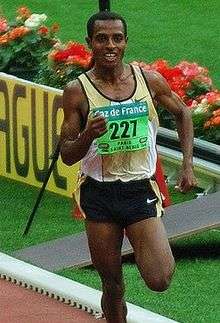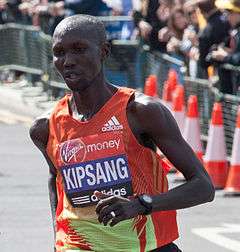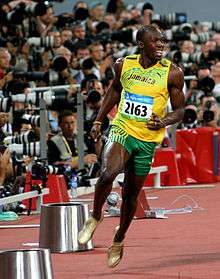Negative split
A negative split is a racing strategy that involves completing the second half of a race faster than the first half. It is defined by the intentional setting of a slower initial pace, followed by a gradual or sudden increase of speed towards the end of the race.[1] Alternate strategies include even splitting (racing at a steady pace) or sit and kick (also known as a sprint finish). Conversely, the act of completing the first half of a race faster than the second half is known as a positive split.[2]
The strategy of negative splitting has been documented in competitive running since the early 20th century. Runners such as Steve Prefontaine, Wilson Kipsang and Galen Rupp have used them in races.
Negative split strategies are also used in swimming (including Janet Evans's 1988 Olympic gold in the 400 m freestyle)[3] cycling, triathlon and horse racing.[4][5][6]
Similar strategies
The strategies discussed below are easily confused with negative splits, because the racer can appear to be negative splitting when they really are not.
Even splitting
Even splitting is a racing strategy where the runner aims for a precise lap time. To do this the runner must run the same split for every lap (or other distance considered a split) to hit the time.[7] For example, if a runner wants to finish a 1600-meter race in 4:40, on a 400-meter track, the runner would have to hit 70 seconds a lap, with each lap counting as a split to achieve this goal. To use this strategy the runner must run their own pace and not get pulled ahead or behind by the other competitors. If the runner falls behind and runs the first part more slowly than intended, they can replace strategy with a negative split to make up for the time gained earlier in the race.
One of the best examples of even splitting comes from Dave Wottle in the 1972 Olympics in the 800-meter finals. Wottle ran a 1:45 for that race, even splitting 26 seconds for each 200-meter split.[8][9] Because the other runners in the race ran so fast at the beginning and slowed at the end, Wottle's finish was much faster.
Sit and kick
This strategy, also known as a sprint finish, relies on the runner hanging with the lead pack for the majority of the race, not pushing the pace or trying to break away, until the bell lap or final section of the race. The runner then makes a kick—increases pace—with all their remaining energy. This strategy relies on the runner having a better kick than the rest of the field. Sitting and kicking can also be confused with negative splitting, especially if the runner employing this strategy makes their kick move earlier than the last 300-meters or so of a race.
Athletes using negative splits
Kenenisa Bekele

Considered by many to be among the greatest runners of all time,[10] Kenenisa Bekele has employed negative split strategies in many of his races and all of his world records.
Most notably, every kilometer in his 5000 meter world-record run of 12:37 was about one second faster than the last. His splits per kilometer were 2:33, 2:32, 2:31, 2:30, 2:29.[11]
Steve Prefontaine
One of the most noted runners in the United States, Steve Prefontaine used negative splits to train and compete in high school. In one example, Prefontaine's goal was to run a 9:44 two-mile, requiring a 73-second pace per lap. Instead of running a flat pace, Prefontaine's coach, Walt McClure, had him run the first six laps at 75 seconds per lap. This put the runner 12 seconds over the pace, at 7:30, at the end of the sixth lap, leaving the last two laps to make up time by negative splitting a 70-second seventh lap and then a 65-second final lap.[12]
Wilson Kipsang

Kipsang has the third fastest marathon time, at 2 hours 3 minutes and 23 seconds, at the 2013 Berlin Marathon.[13] Kipsang ran a year earlier, at the 2012 Honolulu Marathon, finishing with a time of 2 hours 12 minutes and 31 seconds.[14] He won this marathon by negative splitting. Kipsang came through the half waypoint in 1 hour 7 minutes and 7 seconds. He finished the second half of the marathon in 1 hour 5 minutes and 24 seconds.[14]
Galen Rupp
.jpg)
Galen Rupp, an Olympic silver medalist, set a new U.S. record in the 5000-meter race, hitting 13 minutes 1 second at the Boston University Multi-Team Meet.[15] He negative split the race, with his first mile at 4 minutes and 14 seconds, the second mile at 4 minutes and 12 seconds, the third mile at 4 minutes and 4 seconds, leaving his final 200 meters in 30 seconds.[16]
Usain Bolt
Usain Bolt is one of the most known and acknowledged track athletes in the history of track and field. He has set numerous world records in competitive events. He performed a negative split when breaking the 200m record in 2009 at the World Championships.[17]
Advantages of negative splitting
- Negative splitting helps build discipline, subverting the natural instinct to begin running as fast as possible. It takes self-restraint to allow others to run ahead and not be pulled along.
- Starting slow allows the runner's body to compensate for the lactic acid production and low oxygen levels that result from exertion.[18] Lactic acid buildup may cause a runner to slow down unintentionally.
- Progressively increasing speed in any race allows the runner to focus on passing each person running directly ahead.[19]
References
- Henderson, Joe (October 7, 2014). "Negative Reinforcement". Runner's World. Rodale Inc. Retrieved November 12, 2014.
- Race split times. Running For Fitness. Retrieved on 2014-11-21.
- Swim Drills to Build Your Negative-splitting Skills. Active. Retrieved on 2014-11-21.
- Furgele, John (2013-10-31). Breeder's Cup Is As Simple As Following the "Rule". Saratoga Racetrack. Retrieved on 2014-11-21.
- Negative-split strategies. Active. Retrieved on 2014-11-21.
- Murray, Ian (2014-09-29). Q&A: Negative Splitting & Redemption Races. Triathlete Europe. Retrieved on 2014-11-21.
- Friel, Joe; Schwartz, Eric. "Pacing for Better Racing". Endurance One. Retrieved November 16, 2014.
- The race can be watched on YouTube by searching "1972 Olympic 800m Final".
- Moore, Blaine. "The Best Olympic 800m Run in History » Dave Wottle in 1972". www.runtowin.com. Retrieved November 19, 2014.
- "LRC Debate: After Berlin Who is the Greatest of All-Time – Kenenisa Bekele, Haile Gebrselassie or Mo Farah?".
- "Race Your Best 5-K Ever".
- Musca, Michael (October 1, 2006). "Steve Prefontaine's High School Career". Running Times. Rodale Inc. Retrieved November 12, 2004.
- Nakamura, K Ken; Douglas, Scott (September 26, 2013). "The World's Fastest Marathons (and Marathoners)". Runners World & Running Times. Rodale Inc. Retrieved November 12, 2014.
- "Kipsang and Galimova win windy Honolulu Marathon". IAAF athletics. International Association of Athletics Federations. December 9, 2012. Retrieved November 12, 2014.
- "Athlete Profile Galen Rupp". IAAF Athletics. International Association of Athletics Federations. Retrieved November 12, 2014.
- Chavez, Christopher (January 16, 2014). "Rupp shatters American indoor 5K record". Flotrack. Flocasts. Retrieved November 12, 2014.
- Tabakin, Dudley (2009-08-21). "Analyzing Usain Bolt's 19.19 Second 200m World Record". Video Analysis of Sports. Retrieved 2019-02-14.
- "Lactic Acid Test". Medline Plus Trusted Health Information for You. A.D.A.M., Inc. November 7, 2014. Retrieved November 12, 2014.
- Galloway, Jeff (September 10, 2007). "The Positives of Negative Splits". Runner's World. Rodale Inc. Retrieved November 12, 2014.
